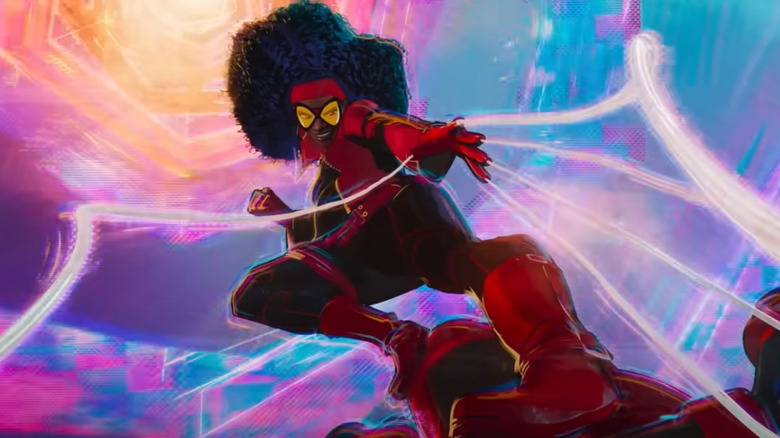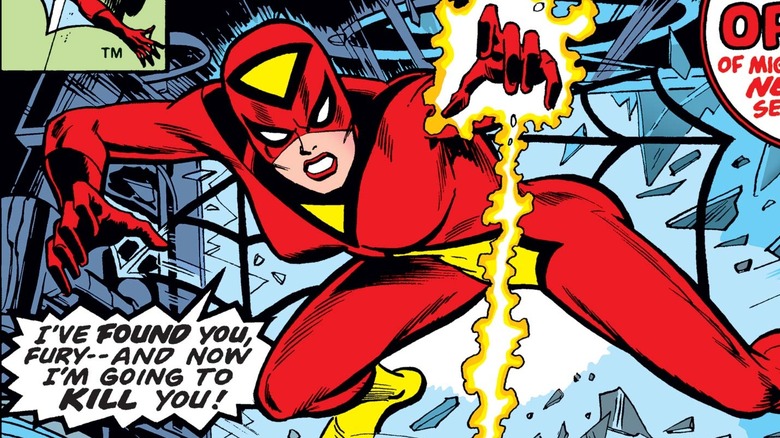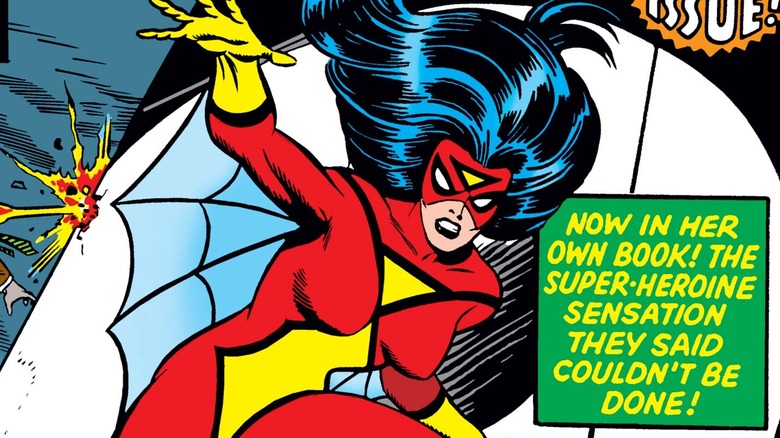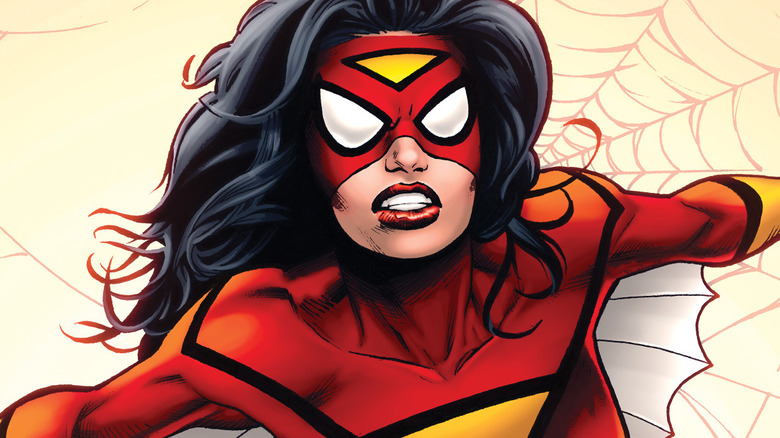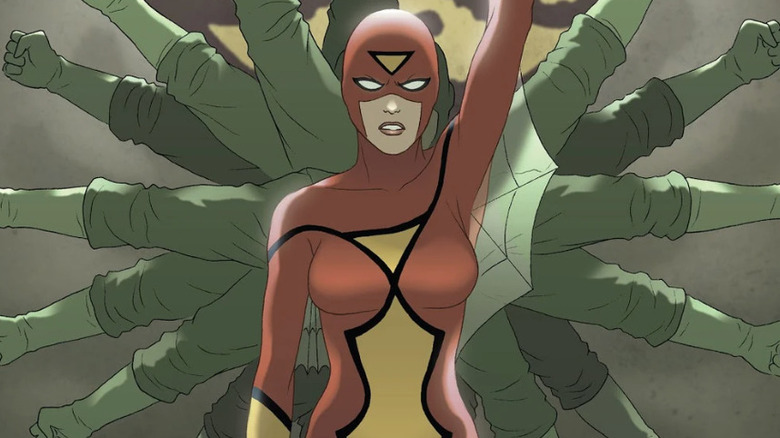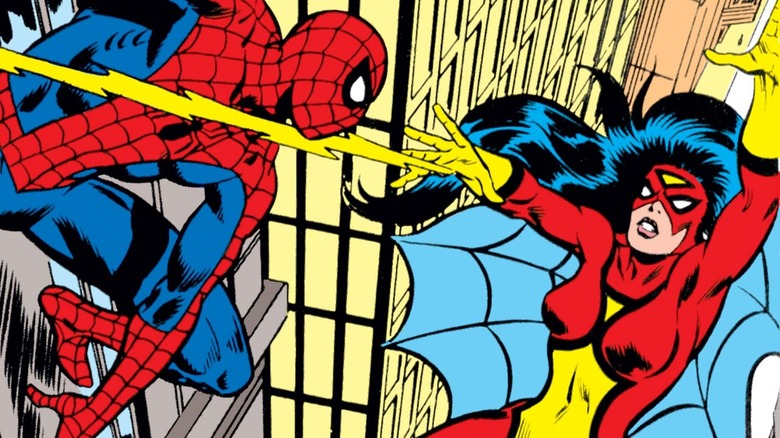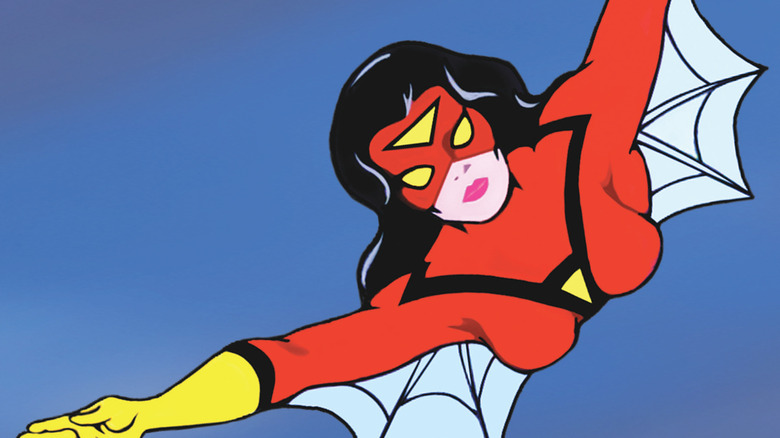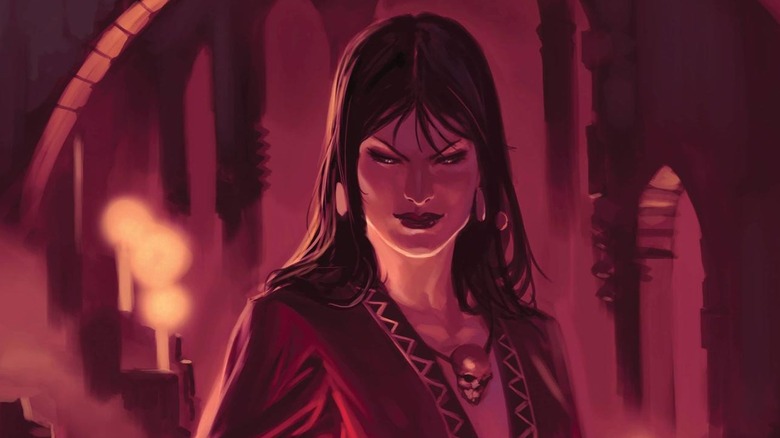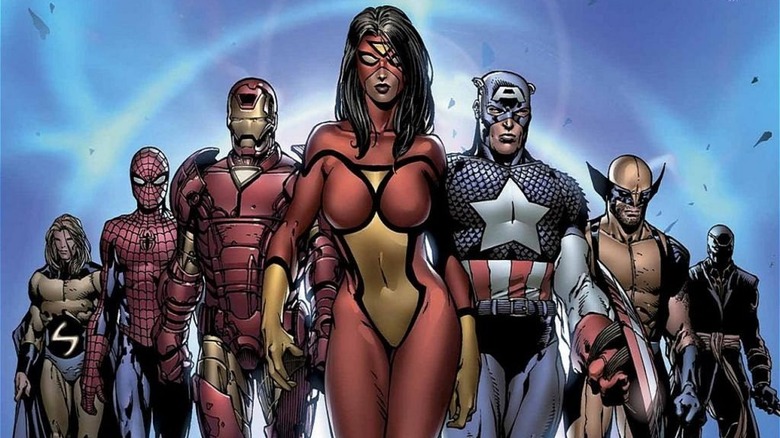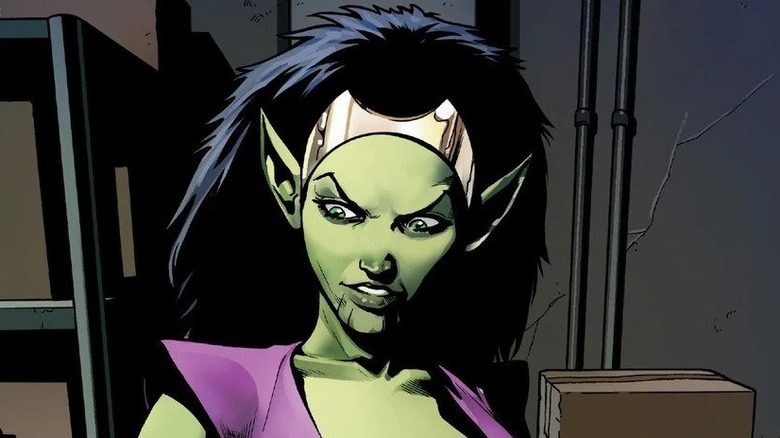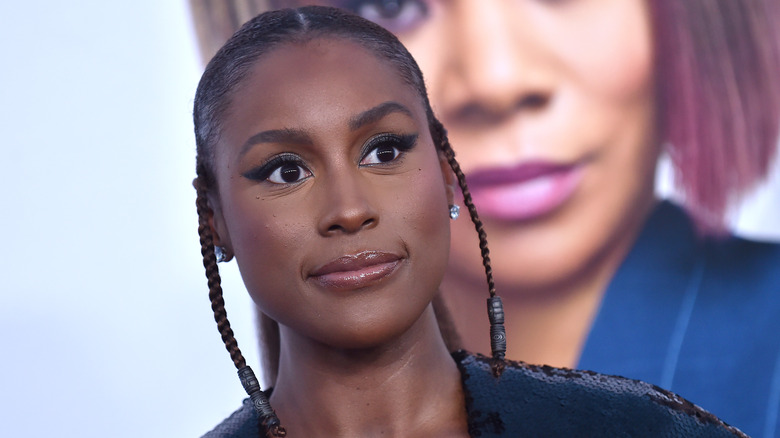Across The Spider-Verse: 10 Things You Need To Know About Spider-Woman
The latest trailer for "Spider-Man: Across the Spider-Verse" reveals a friendly neighborhood multiverse like no other, absolutely crammed with webheads of all shapes and sizes. From fan favorites like the Bombastic Bag-Man to deeper cuts like Spider-Man Unlimited (the star of the '90s cartoon sequel series), each frame of Miles Morales' highly anticipated return to movie theaters is Kirby-dotted with copious cameos.
Amidst a heartful Morales family pep talk and new footage of a particularly antagonistic Spider-Man 2099, the trailer also introduces another presumably prominent member of the film's cast, Spider-Woman, an oft-forgotten member of the Spider-Verse, despite being one of Marvel's few legacy female superheroes. Who is Spider-Woman? And why isn't she more well-known as the female equivalent of the world's most famous superhero? If you're wondering who's serving a sepia-toned Vulture some fresh hot torque in the trailer, we've got you covered. Here are 10 things you need to know about Spider-Woman.
Her name is Jessica Drew
Created by writer Archie Goodwin and designed by artist Marie Severin, Spider-Woman debuted in "Marvel Spotlight" #32 in February 1977, 15 years after Peter Parker first swung onto the scene. The brainchild of newly-minted Marvel Comics president Stan Lee, "Marvel Spotlight" was an anthology comic series created as a testing ground for introducing superheroes with more niche angles than what had come to be expected from the House of Ideas. Ghost Rider and Werewolf by Night are just two of the many heroes who first arrived in the pages of "Marvel Spotlight."
"Marvel Spotlight" #32 introduces Spider-Woman, aka Jessica Drew (not to be confused with detective Jessica Jones), a deadly, acrobatic supervillain with a shadowy past. Like Johnny Blaze and Jack Russell before her, Jessica was given a series of her own, with writing duties handed over to comics legend Marv Wolfman, who reinvented her (much as he would DC's Teen Titans a few years later).
The power of dibs
The history of comic books is a fascinating series of silly scandals and larger-than-life personalities, accentuated by the social upheaval and cultural evolution of 20th-century America. A recurring theme in the medium's history is the weird ways in which copyright and character ownership have been handled. As strange as it may seem, logistical mischief was the most important factor in Spider-Woman's conception.
In an interview with "The Comics Journal" in 1978, Stan Lee admitted he had grown concerned other comic companies like DC would take a name with as much built-in familiarity as "Spider-Woman" before Marvel, so he quickly put her creation into motion. This isn't the only time a female Marvel superhero counterpart was created to avoid copyright disputes, as She-Hulk shares a similar real-life origin story with Spider-Woman. It's a strange tale — a legacy superhero with multiple comic series, redesigns, and decades of continuity, all for the sake of calling dibs.
Spider-Woman, in that order
No great idea ever starts that way, and this is especially true for Ms. Drew. "Marvel Spotlight" #32 may seem the natural starting point for Spider-Woman the same way "Amazing Fantasy" #15 was for Spider-Man, but it's a standalone explanation that was erased from canon as soon as it became clear Spider-Woman was here to stay. At first, it seems simple enough. Jessica Drew was raised in a small European village and was shunned for her miraculous superpowers, but as the story draws to a close, the truth surfaces.
Upon confronting Nick Fury, Spider-Woman is informed that her formative years abroad were memory implants created to hide her true upbringing. Jessica Drew is a member of the New Men, a race of human-sized animals brought to life by the High Evolutionary (whom global audiences will get to know in the upcoming "Guardians of the Galaxy Vol. 3"). This whole time, Jessica Drew wasn't a person but an evolved spider that looked exactly like an adult woman. It is an utterly absurd origin story and likely the result of rushing the character to the public to maintain a trademark on the character's name.
A history with HYDRA
In May 2016, many Marvel fans cried foul when the debut issue of "Captain America: Steve Rogers" revealed the Sentinel of Liberty was an undercover agent for HYDRA. Though the controversial move, which was reversed a month later as planned, rubbed fans the wrong way, curious readers could go searching and discover Rogers' supposed turn to the dark side was just the latest in a long history of superheroes having secret pasts with the fascist organization. Spider-Woman is one of the earliest examples of this tradition, as Marv Wolfman's reworking of the character swapped out her arachnid origins for good old-fashioned brainwashing.
As previously mentioned, Jessica Drew had come to believe she was actually a spider that looked identical to a human at the end of her story. However, that revelation itself was a second case of memory implantation. Jessica's powers derive from a spider-based serum her father developed to save her from a terminal illness. When she grew up, she was kidnapped by a HYDRA operative and transformed into a weapon before eventually regaining her memories and escaping. In attempting to redirect the character's canon, Wolfman backpedaled and restored Jessica's humanity, and she's been a reformed hero ever since.
A tale of two Spider-People
When discussing differently gendered variations of superheroes, there's a tendency to assume the characters are inherently linked to their forebearer. There's certainly precedent for it. Supergirl and She-Hulk are cousins to their respective counterparts, and Batgirl is the daughter of Commissioner Gordon, Batman's friend and ally. There even exists a "Spider-Girl," who is the alternate-universe daughter of Peter Parker and Mary Jane Watson (who will also be making an appearance in "Across the Spider-Verse").
So it would seem natural that the most popular superhero in the world would have a female variation with some sort of connection to him. Surprisingly, Peter Parker and Jessica Drew have next to none. Sure, they fight on the same side and have teamed up on occasion, but on the whole, Jessica lives wholly apart from her Spider-brethren. That extends to her power set, as the heroes only share a handful of abilities. Jessica even possesses bio-electrical powers, which pairs her better with Miles Morales than Peter Parker. In that sense, her highest-profile appearance in Miles' second movie is pretty fitting.
Animated on the Drews
Although "Spider-Man: Across the Spider-Verse" marks Jessica Drew's big-screen debut, this isn't the first time she's been brought to life on the twos. A glance at the storied history of Marvel multimedia shows that the same handful of heroes, such as Spider-Man, the X-Men, and the Avengers, receive animated serialized adaptations on the regular. And then, there's "Spider-Woman," which exists despite the piles of data suggesting the character has never been popular outside of the hardcore comics crowd (though recent research may prove otherwise).
Following in the footsteps of the character's counterpart, Spider-Man, and his much more famous cartoon from the late '60s, "Spider-Woman," which aired from September 1978 to January 1979, is one of many cheaply produced Marvel animated series from the 1970s. The series lasted a scant 16 episodes, and its approach to adapting the source character and her world is suspect at best, but it's nonetheless a decent cartoon. "Spider-Woman" is currently available on the Disney+ streaming service.
One enchanted enemy
Supervillains and superheroes are package deals. One cannot exist without the other, and the same holds true for Spider-Woman. Unlike the vast majority of superheroes, Spider-Woman's original archenemy has a history of her own that far outweighs Jessica Drew's. In fact, it spans centuries. Morgan le Fay, the wicked enchantress of Arthurian lore, served as Spider-Woman's archenemy in her first standalone series and has been bouncing around Marvel canon ever since.
In many respects, Morgan follows the line of other Marvel characters with real-world mythological backgrounds, such as Thor and Hercules, taking the general premise of the original character but leaving lots of room for Marvel writers to put their own spin on one of literature's first formidable foes. Although she's recognized more as an enemy of Doctor Strange (and an ex-girlfriend of Dr. Doom, amazingly) today, Morgan's influence on Jessica Drew's early adventures is undeniable. It's safe to say Spider-Woman wouldn't be the same without her.
A team player
Sometimes, heroes do better in groups, and Jessica Drew is undoubtedly a team player. In stark contrast to Spider-Man, best known for his solo exploits, Spider-Woman has been a member of various Marvel super-teams. Jessica is much closer to tactical espionage organizations like S.W.O.R.D. and S.H.I.E.L.D. than she is to the superpowered street crimes rampant across Spidey's territory. She's also dealt with the occult (hence her affiliation with Morgan le Fay) and has spent time with obscure teams like Strikeforce and the Lady Liberators.
In late 2004, Jessica Drew was reintroduced as a core member in the relaunched "New Avengers" series by famed comics writer Brian Michael Bendis. Through this series, Jessica became a more recognized resident of the expansive Marvel canon, in her universe and our own. What new fans and old didn't realize was that Bendis had plans for Jessica that would forever change the character.
A Skrull among us
For decades, the Marvel Universe has tested positive for an all-too-literal case of imposter syndrome. The shape-shifting Skrulls have been wreaking havoc in some form or another for over 60 years. Surprise Skrull reveals are a long-standing Marvel tradition, and nearly every Marvel hero has succumbed to it, including Spider-Woman. Jessica Drew's unmasking as a Skrull might be one of the most important in the company's history, as she was smack-dab in the middle of the alien race's widespread takeover of the superhero community in the "Secret Invasion" series.
The limited series revealed the Jessica Drew that had been part of the New Avengers since its first issue was Veranke, the queen of the Skrulls, who perfectly replicated Jessica's DNA to become a perfect copy of Spider-Woman and successfully infiltrated the superhero scene, where she remained for years. The invasion was eventually thwarted, and the real Jessica Drew was freed from her Skrull imprisonment, but the revelation that the person calling herself Spider-Woman was an imposter for the previous four years of stories (just as Bendis intended) recontextualized the character's history. It's safe to say the MCU's upcoming adaptation of "Secret Invasion" won't be the same without one of the source material's most important impersonations.
A Rae forward for Spider-Woman
As you've seen, Spider-Woman's original design is much different than her look in "Across the Spider-Verse." In the upcoming film, she sports a sick motorcycle, and her skin-tight suit has been replaced with a much more stylish wardrobe that still carries the character's signature red and yellow color scheme. Most significantly, Spider-Woman in "Across the Spider-Verse" is a Black woman, whereas she is caucasian on Earth-616, the central Marvel canon (though a Black "Spider-Woman" with a similar afro hairstyle did exist in the little-known "Spidey Super Stories" comic from the '70s).
Additionally, this instantly-iconic redesign is paired with a new voice actor, YouTube legacy star and "Insecure" co-creator Issa Rae. It's especially significant for Ms. Drew, who's only had one other major redesign in the mid-2010s. Given the popularity and accessibility of superhero movies — especially in comparison to their comic book source material — it's almost guaranteed this bold new interpretation of Jessica Drew will become the most recognizable version of the character. A new chapter in the quasi-obscure history of Spider-Woman is about to begin.
